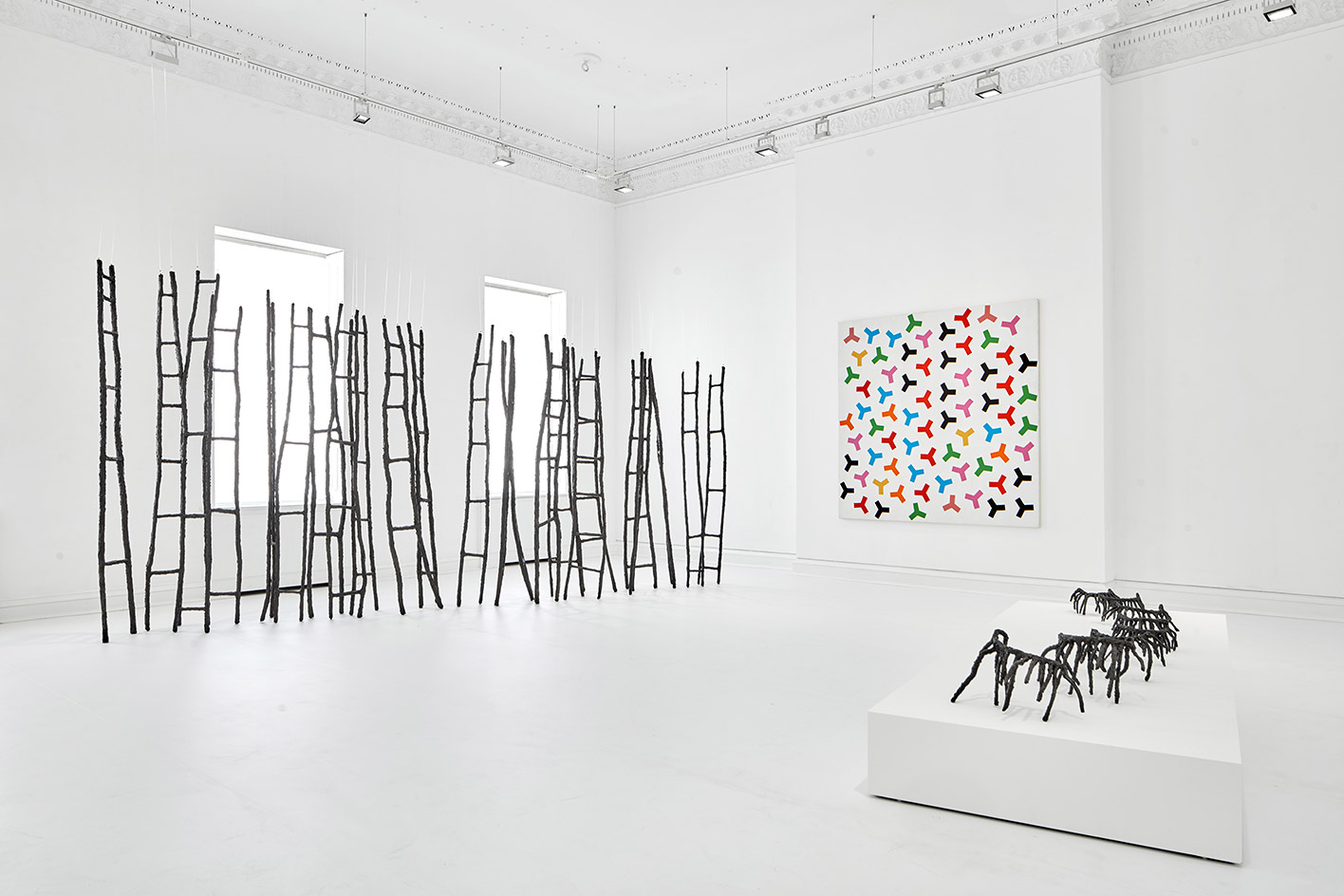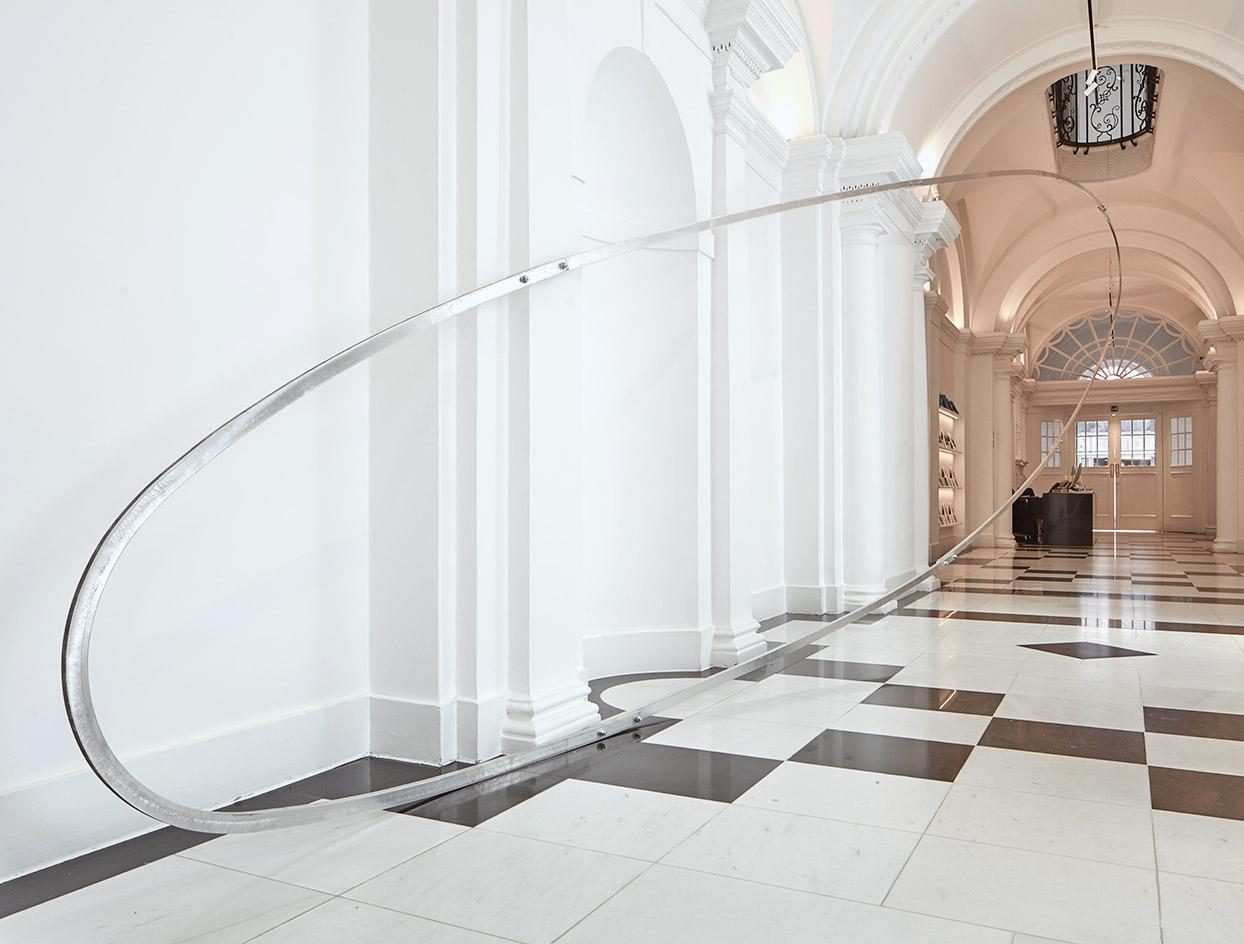The trio of pioneering female artists who took on minimalism in the 1960s and 70s

An exhibition opened at London’s Galerie Thaddaeus Ropac celebrates three pioneering female artists of the minimal and post-minimal movements. Wanda Czelkowska, Lydia Okumura and Rosemarie Castoro each subverted the avant-garde tendencies of the 1960s and 1970s in their own right, offering fresh and radical and perspectives on sculpture and painting in a male-dominated landscape.
The 18th-century, Grade I listed Ely House on Dover Street is an apt location: as a former private members’ club, it was one of the first to allow women to grace its doors in 1909. The exhibition concept stemmed from a conversation in 2016 between gallery owner Ropac and curator Anke Kempkes when it transpired that each artist was on the cusp of landing a major retrospective. It highlights the different experiences between female artists and their male counterparts during the 60s and 70s. ‘The men had people telling them to keeping doing what they were doing, women like this didn’t,’ Kempkes remarks.

Installation view of Wanda Czelkowska’s work at Galerie Thaddaeus Ropac, London
When Wanda Czelkowska began her career, she was resistant to the rigid and restive mood of her native Poland, then under the shadow of communism. Tensions eased in the late 50s following Stalin’s death and she began a series of ‘awkward’ and whimsical structures as a parody of the political system. Czelkowska focused ‘obsessively’ on her signature ‘head motif’— three are displayed here – influenced by Etruscan and Minoan cultures.
‘When we asked whether she thought these heads were male or female, she wisely said they were a “third gender”’, Kempkes recalls. The drastic evolution of Czelkowska’s five-decade career will be laid bare, morphing through neo-primitivism, 60s abstraction to the introduction of stark-edged brutalist deconstructions. The artist still lives and works alone from her factory studio in Mokotów, the ‘hipster’ district of Warsaw, alongside her entire legacy of work.
Lydia Okumura’s immersive wired installation using intelligent optical colour fields was first realised in 1984, and is displayed here in an altered format. ‘I don’t think it matters that it’s not the same as it was,’ Okumura told us while preparing her colossal reel of wired mesh for her sculpture. The São Paulo-born Japanese artist draws inspiration from a number of sources such as land art and the anti-establishment wave of Arte Povera. ‘It’s astonishing that she does all of this in her head’, admires Kempkes of Okumura’s analytical and rigidly mathematical work.

Rosemarie Castoro performing in her Soho studio, New York, in the 1970s.
Rosemarie Castoro was at the core of New York’s 1960s minimalist wave, sharing a Soho apartment with her then husband and famed ‘grid’ sculptor, Carl Andre. She initially pursued a career in dance, but, according to Kempkes ‘stopped because she disliked the lack of creative freedom’. But even after Castoro entered realm of hard-edge minimalist abstraction, movement and dancers’ treatment of space remained key forces in her work.
Here, her work occupies the entire first floor of the gallery, including a series of primitive epoxy ‘DNA ladders’ titled Land of Lads, and a parade of eerily oversized eyelash ‘creatures’, moulded in the same material, titled Land of Lashes. The latter’s horizontal forms, contrasted with the former’s verticality, can be read as a commentary on the stagnation of women artists’ careers. Yet, with their expressive forms and monumental presence, the lashes appear to be marching on, just as the arc of art history finally begins to bend towards equality.

Installation view of Lydia Okumura Land’s works at Galerie Thaddaeus Ropac, London
Information
‘Land of Lads, Land of Lashes’ is on view until 11 August. For more information, visit the Galerie Thaddaeus Ropac website
Address
Galerie Thaddaeus Ropac
Ely House
37 Dover Street
London W1S 4NJ
Receive our daily digest of inspiration, escapism and design stories from around the world direct to your inbox.
Harriet Lloyd-Smith was the Arts Editor of Wallpaper*, responsible for the art pages across digital and print, including profiles, exhibition reviews, and contemporary art collaborations. She started at Wallpaper* in 2017 and has written for leading contemporary art publications, auction houses and arts charities, and lectured on review writing and art journalism. When she’s not writing about art, she’s making her own.
-
 The international design fairs shaping 2026
The international design fairs shaping 2026Passports at the ready as Wallpaper* maps out the year’s best design fairs, from established fixtures to new arrivals.
-
 The eight hotly awaited art-venue openings we are most looking forward to in 2026
The eight hotly awaited art-venue openings we are most looking forward to in 2026With major new institutions gearing up to open their doors, it is set to be a big year in the art world. Here is what to look out for
-
 This modern Clapham house is nestled indulgently in its garden
This modern Clapham house is nestled indulgently in its gardenA Clapham house keeps a low profile in south London, at once merging with its environment and making a bold, modern statement; we revisit a story from the Wallpaper* archives
-
 Out of office: The Wallpaper* editors’ picks of the week
Out of office: The Wallpaper* editors’ picks of the week'Tis the season for eating and drinking, and the Wallpaper* team embraced it wholeheartedly this week. Elsewhere: the best spot in Milan for clothing repairs and outdoor swimming in December
-
 Out of office: The Wallpaper* editors’ picks of the week
Out of office: The Wallpaper* editors’ picks of the weekFar from slowing down for the festive season, the Wallpaper* team is in full swing, hopping from events to openings this week. Sometimes work can feel like play – and we also had time for some festive cocktails and cinematic releases
-
 The Barbican is undergoing a huge revamp. Here’s what we know
The Barbican is undergoing a huge revamp. Here’s what we knowThe Barbican Centre is set to close in June 2028 for a year as part of a huge restoration plan to future-proof the brutalist Grade II-listed site
-
 Out of office: The Wallpaper* editors’ picks of the week
Out of office: The Wallpaper* editors’ picks of the weekIt’s wet, windy and wintry and, this week, the Wallpaper* team craved moments of escape. We found it in memories of the Mediterranean, flavours of Mexico, and immersions in the worlds of music and art
-
 Each mundane object tells a story at Pace’s tribute to the everyday
Each mundane object tells a story at Pace’s tribute to the everydayIn a group exhibition, ‘Monument to the Unimportant’, artists give the seemingly insignificant – from discarded clothes to weeds in cracks – a longer look
-
 Out of office: The Wallpaper* editors’ picks of the week
Out of office: The Wallpaper* editors’ picks of the weekThis week, the Wallpaper* team had its finger on the pulse of architecture, interiors and fashion – while also scooping the latest on the Radiohead reunion and London’s buzziest pizza
-
 Out of office: The Wallpaper* editors’ picks of the week
Out of office: The Wallpaper* editors’ picks of the weekIt’s been a week of escapism: daydreams of Ghana sparked by lively local projects, glimpses of Tokyo on nostalgic film rolls, and a charming foray into the heart of Christmas as the festive season kicks off in earnest
-
 Wes Anderson at the Design Museum celebrates an obsessive attention to detail
Wes Anderson at the Design Museum celebrates an obsessive attention to detail‘Wes Anderson: The Archives’ pays tribute to the American film director’s career – expect props and puppets aplenty in this comprehensive London retrospective